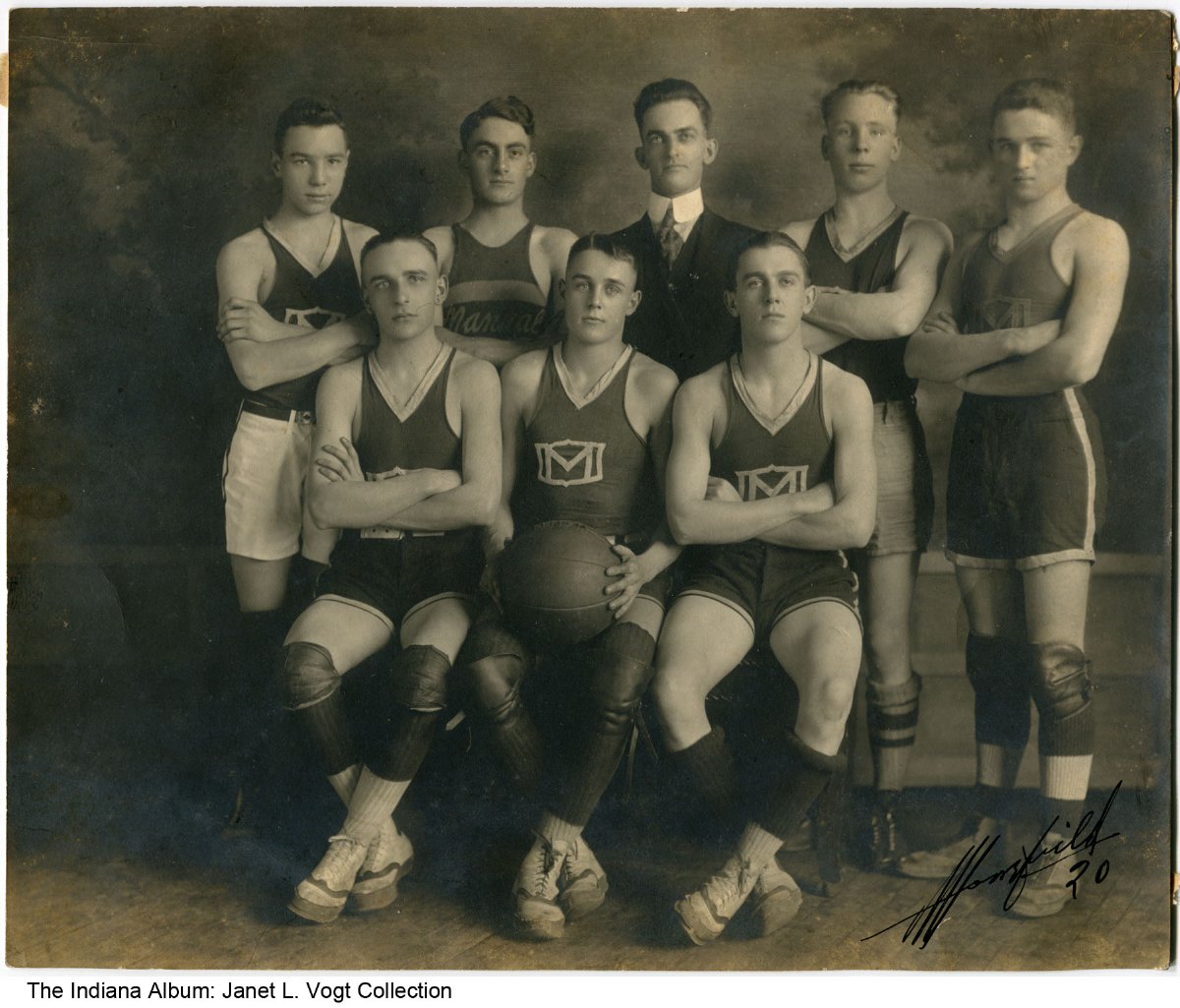While particulars of the first basketball game played in Indianapolis have not been established, a game likely transpired at the Illinois Street in 1894. Reverend Nicholas McKay, an associate of Dr. James Naismith, basketball’s inventor, reportedly introduced the game to the Crawfordsville YMCA in 1893, and the Indianapolis “Y” likely adopted the game soon thereafter. By the winter of 1897-1898 the local “Y” was hosting a four-team intramural league, and the Y All-Stars capped the season by defeating the University of Indianapolis (not the current ).
The emergence of basketball as a major sport in Indianapolis occurred at on February 6, 1900. With over 1,000 fans present, Mayor tossed the first center jump as Yale University defeated the Indianapolis YMCA All-Stars 33-13. and were to inaugurate their rivalry following the main event. Manual, however, showed up with two players who were not students at the school, so Shortridge was left to conquer the Yale reserves 6-4.
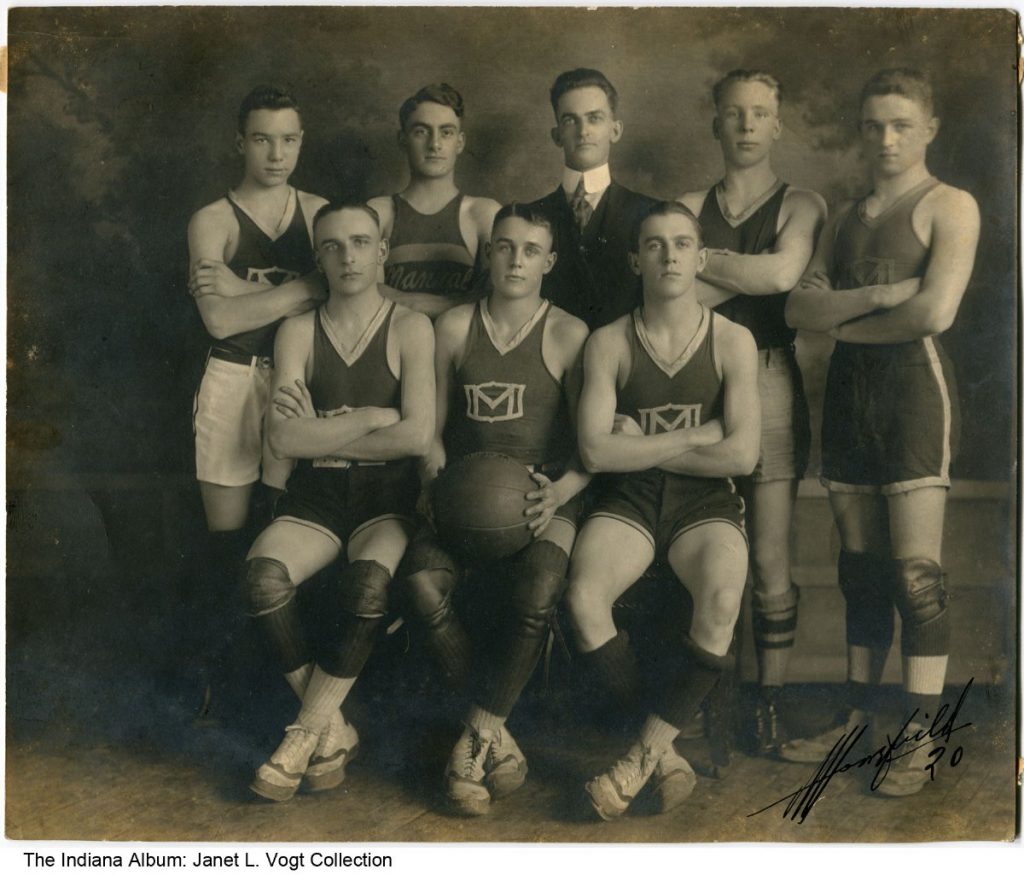
In the weeks following this historic event, the Y All-Stars announced a six-game schedule that included bouts with and Indiana Normal School, and with YMCAs in Cincinnati and Wisconsin. Local newspapers heartily advanced prospects for the formation of a statewide college-YWCA basketball league. Though a state league was still a few years removed, an Indianapolis city league began contesting games before average crowds of 500 in January 1901. The Y All-Stars continued their customary dominance by going undefeated against Butler, Manual, and Shortridge in a six-game schedule. The league continued for many years.
Evidence of the passion generated by the new game is found in reports of a February 1901 match. A member of the Butler squad took exception to being pelted with lemons hurled by Shortridge supporters. Entering the stands, he snatched a pennant from a Shortridge coed and made off with it. The ensuing riot reportedly resulted in considerable ill will.
In addition to YMCA and Butler games against regional foes, Shortridge held a home-and-home series versus Crawfordsville High School in 1901. Primarily based on capturing both battles, Crawfordsville proclaimed itself the Indiana High School Basketball Champion. Crawfordsville followed the same course against Manual in 1905.
A virtual basketball explosion rocked Indianapolis during the first decade of the 20th century. Local sports pages featured ads placed by high schools, YMCA teams, the , churches, neighborhood teams, and barnstorming semi-pro squads seeking games against “any fast basketball teams.” A loosely organized Indiana College Athletic Association formed and by 1905 Butler was vying with Indiana University (IU), Indiana Normal, Wabash College, and among others.
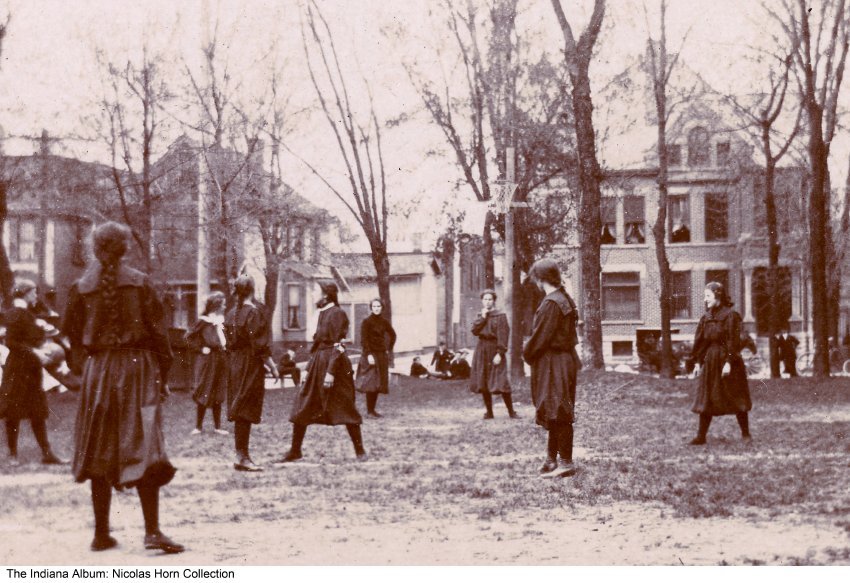
Indianapolis girl’s basketball experienced a more fitful genesis. Shortridge organized Indiana’s first female intramural program in 1898. By 1901 the school was contesting Butler, Manual, the Girls Classical School, and the Indianapolis German House (see ). Yet female basketball players of the era generated substantial controversy. Following a 1905 game between Shortridge and Butler, three high school boys were discovered hiding in the balcony. This violation of strict prohibitions against male attendance at female competitions resulted in threats to cancel all games featuring women athletes. Butler opened attendance to everyone the following season, and both schools continued to field popular girl’s basketball programs.
Interest in Indianapolis boy’s high school basketball grew unabated. By 1903 interscholastic athletic contests were so commonplace that a statewide governing body was needed. When the (IHSAA) was organized in 1904, Manual and Shortridge High Schools were among the 15 charter members.
Despite this fact, neither school participated in the state’s first official high school basketball tournament which was held in 1911. The IU Booster Club invited one team from each of the state’s 13 congressional districts to compete for the championship in Bloomington. Since the IHSAA had not expressly sanctioned the tournament, and because board members believed that the games would distract from participants’ studies, the Indianapolis School Board refused to allow local schools to compete.

Opposition to the tournament soon subsided and Indianapolis schools began vying for state honors. Manual advanced to the Final Four game in 1915, finished as state runner-up in 1929 and 1934, Shortridge reached the Final Four game in 1933, and Broad Ripple High School followed suit in 1945. Tech’s Emmett Lowery received the prestigious Gimbel Medal for mental attitude in 1929, while Shortridge’s Jim Seward won the same honor in 1933. Broad Ripple’s Max Allen earned the first Trester Award, which replaced the Gimbel Medal in 1945. Lowery and Tech’s Leroy Edwards and Johnny Townsend won All-America honors at Purdue, Kentucky, and Michigan respectively. Edwards and Townsend also pursued careers with the National Basketball League during the 1940s.
The local university mirrored the city’s high school successes. Harlan “Pat” Page starred with powerhouse University of Chicago teams before becoming Butler’s head basketball coach in 1920. During the next six seasons, Page’s Butler Bulldogs compiled a 94-29 record, and his 1924-1925 team won the (AAU) National Collegiate Championship. In 1962 Page entered the Naismith Basketball Hall of Fame for his exploits as a collegiate player.
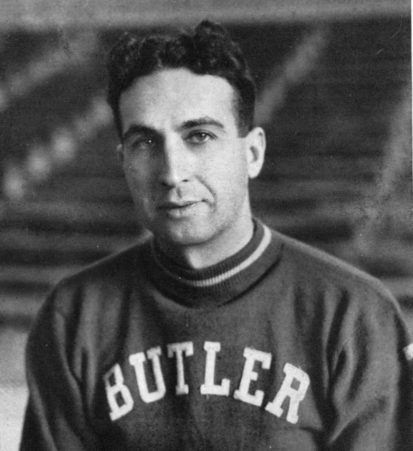
When Pat Page left Indianapolis to become head football coach at IU in 1926, his assistant, , succeeded him. Hinkle’s tenure at Butler marked the most successful era in Indianapolis collegiate basketball to date. Led by future New York Yankee pitcher Oral Hildebrand, the 1929 Butler Bulldogs compiled a 17-2 record and captured their second AAU National Collegiate Championship. All-Americans Frank Baird (1934), Jerry Steiner (1940), Bob Dietz (1941), Jimmy Doyle (1949), and Ralph “Buckshot” O’Brien (1949) produced expectations of success at the northside campus. All but Doyle pursued careers with pioneer professional basketball leagues of the period.
Butler’s triumphs made attendance at the school’s games a staple of the Indianapolis social scene. Interest became so intense the school constructed one of the nation’s first great athletic fieldhouses. In an era of 5,000-seat gymnasiums, Butler Fieldhouse accommodated 15,000 fans at its March 1928, inauguration. The fieldhouse was the site of the annual IHSAA Boys Basketball Tournament from 1928 to 1972 and hosted the Indiana Kentucky High School All-Star Games from 1940 to 1974. The first IHSAA Girls Basketball Finals were held at the arena in 1976. The fieldhouse hosted the first US-USSR basketball game, a U.S. Olympic Basketball Trial, an American Basketball Association All-Star Game, and was home to four professional basketball teams. Butler Fieldhouse was rechristened in 1966.
The foundation of professional basketball in Indianapolis is found in the Marion County Sunday School Basketball League and Indiana’s independent teams. Central Christian Church dominated the Sunday School League, winning championships from 1914 to 1917. Likewise, the Detch Specials, sponsored by Indianapolis’ Detch Wheel Company, reigned as Indiana Independent champions in 1913 and 1914. By 1916 several Central Christian teammates had joined a number of the Detch Specials to form a semi-pro barnstorming team. The squad added select high school and college players, gained the sponsorship of Indianapolis’ Em-Roe Sporting Goods Company, and quickly became one of the dominant teams in Indiana sports history.
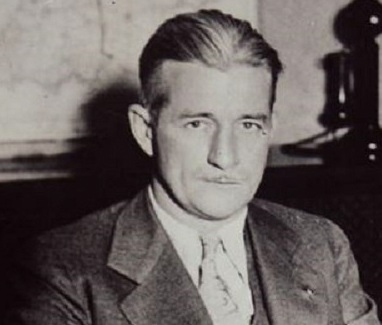
From 1912 to 1924 the Detch Specials or Em-Roes won over 90 percent of their 425 games against Indiana colleges, YMCA and high school teams, and the Original Celtics, Buffalo Germans, and other national barnstormers of the era. Future Indianapolis mayor played for the team, as did Wingate High School legend Homer Stonebraker. Ward Lambert was with the Em-Roes before coaching Purdue to 11 Big Ten crowns. hampered the Em-Roes’ ability to find players and competition, and the barnstormers’ heyday ended during the 1920s. Professional teams began forming leagues with standard rules, rosters, and schedules. While Indianapolis’ debut in such a league required the passing of a decade, the city’s basketball reputation was established.
Grocer Frank Kautsky sponsored powerful AAU and semi-pro teams that played at the Dearborn gym in the 1930s. When a second incarnation of the National Basketball League (NBL) began in 1937, the Indianapolis Kautskys joined as a charter member. Teams from Akron, Buffalo, Cincinnati, Columbus (Ohio), Dayton, Kankakee, and Pittsburgh, the Whiting Ciesar All-Americans, and Fort Wayne Zollner Pistons were also original members. Chicago, Sheboygan, Detroit, Toledo, and the Anderson Duffy Packers soon came aboard.
With this amalgam of franchises in such disparate cities, the NBL had trouble establishing a major league identity. The NBL was nevertheless the genesis of the National Basketball Association (NBA), and Indiana teams formed the league bedrock throughout its 13-year existence. Fort Wayne won the NBL title from 1943 through 1945 and finished runner-up in 1947. Led by former Indianapolis Cathedral High School star Charley Shipp, Anderson reached the semifinals in 1948 and captured the last NBL crown in 1949.
While Indianapolis could not boast commensurate success, the franchise enjoyed its moments. IU All-America Ernie Andres signed in 1940 and became the Kautskys’ star. Though military service and a season with baseball’s Boston Red Sox interrupted his basketball career, Andres returned to coach the Kautskys to a 1947 NBL runner-up finish.
The end of saw the return of a host of young athletes seeking employment and pro basketball men searching for larger markets. Ward Lambert left Purdue to become NBL commissioner in 1946. In one of his first moves, he signed DePaul All-American George Mikan to a contract with the Minneapolis Lakers. Lambert’s disciple and future Indianapolis resident Doxie Moore succeeded his mentor as NBL commissioner in 1949 and immediately became immersed in one of America’s great professional sports wars.
The Basketball Association of America (BAA), formed in 1948, was ready to challenge the NBL’s Andersons and Oshkoshs with the likes of the Boston Celtics and New York Knickerbockers. The Kautskys, rechristened the Indianapolis Jets, abandoned the NBL for the BAA before the 1948-1949 season. The Jets floundered to a last place 18-42 finish in their only BAA campaign. In the fall of 1949 NBL clubs from Anderson, Sheboygan, and elsewhere merged with the BAA to form the National Basketball Association. Doxie Moore was named the league’s first supervisor of officials. Teams from Oshkosh, Dayton, and Hammond vanished and the Jets were replaced by yet another new franchise—the Indianapolis Olympians.
The Olympians are in many ways the most intriguing story in Indiana basketball history. The University of Kentucky (UK) claimed the 1948 and 1949 NCAA titles. As a reward, the core of UK’s team represented the U.S. at the 1948 Olympics. Before the 1949-1950 NBA season the Indianapolis Jets fell into receivership. Kentucky stars Alex Groza, Ralph Beard, “Wah Wah” Jones, and Cliff Barker among others purchased the franchise and renamed it the Olympians in honor of their recent accomplishments. The Olympians packed Butler Fieldhouse. Groza trailed only George Mikan among league scorers, and the team won the NBA’s first Western Division crown. Indianapolis’ place in pro basketball appeared secure.
In January 1950, a major point-shaving scandal rocked college basketball. Many players from collegiate powerhouses were implicated. Groza and Beard were banned from the NBA for life following the 1950-1951 season for shaving points while at Kentucky. A knee injury severely limited Jones’ career. The heart went out of the team and the franchise collapsed following the 1953 season.
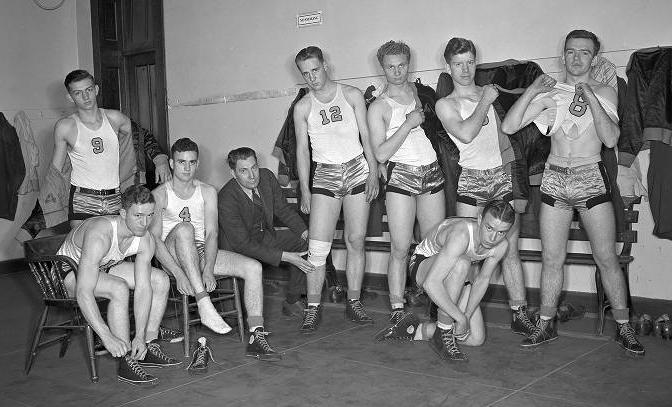
Just as Indianapolis’ professional franchise disappeared, a local high school emerged to champion the city’s basketball fortunes. , opened in 1927 to segregate Marion County’s black students, was barred from playing in the IHSAA state tournament until 1943. The IHSAA also banned Indiana’s parochial and institutional schools from state tournament play. Cathedral High School had assuaged the slight by capturing four Indiana Catholic championships and the 1933 National Catholic title. The won seven Central States Deaf Schools championships and National Deaf Schools crowns in 1935, 1940, and 1987.
Attucks’ vindication came soon after the school’s admission to the IHSAA. was named head coach in 1950 and he quickly established a high school dynasty. Crowe’s teams compiled a 193-20 slate and won the 1955 and 1956 State Championships. Bob Jewell earned the 1951 Trester Award, and several Tigers, led by and Hallie Bryant, signed contracts with the Harlem Globetrotters.
Attucks’ Bailey Robertson established numerous Indiana Central College (University of Indianapolis) scoring records during the 1950s. His brother, Oscar, was named Indiana’s Mr. Basketball in 1956, was three-time College Player of the Year at the University of Cincinnati, became an eleven-time NBA All-Star, and with Kareem Abdul Jabbar led Milwaukee to the 1971 NBA crown. The “Big O” is ranked in the top ten in numerous NBA statistical categories and was inducted into the Naismith Basketball Hall of Fame in 1979.
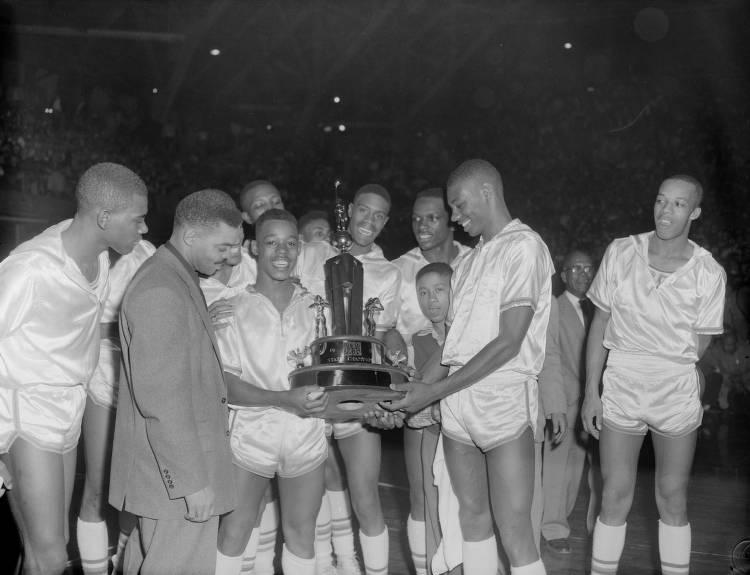
When Ray Crowe became athletic director in 1958, Attucks continued to excel. Bill Garrett of Shelbyville, 1947 Mr. Basketball and All-American at IU in 1951, coached Attucks to the school’s fifth Final Four game and third State Championship of the decade in 1959. The Crispus Attucks example of discipline, organization, and success contributed significantly to the breakdown of racial barriers in Indiana athletics.
Attucks’ legacy is an example of the city’s high school basketball heritage. Joe Sexson became Indianapolis’ first Mr. Basketball and third Trester Award winner when he led Tech High School to a 1952 state runner-up finish. Tech returned to the Final Four in 1966, falling in the title game. In 1961 Tom and Dick Van Arsdale took Manual to the championship game before succumbing in overtime. The twins were Indiana’s first co-Mr. Basketballs and co-Trester Award winners. The Van Arsdales led IU to a 19-5 mark in 1965 and were named second-team All-Americans. Both enjoyed lengthy NBA careers, with each being named to three All-Star Teams.
Shortridge made one last Final Four appearance, finishing runner-up in 1968, but it was Washington High School that ruled Indianapolis high school basketball in the 1960s. Bill Keller, Mr. Basketball, led Washington to the 1965 crown before teaming with Rick Mount on Purdue’s 1969 NCAA runner-up squad. Keller excelled with the American Basketball Association’s (ABA) during the 1970s.
George McGinnis soon surpassed Keller’s achievements. With teammate Steve Downing, McGinnis led Washington to a 31-0 record and the 1969 state title. Named Mr. Basketball, McGinnis starred briefly at IU before embarking on an 11-year pro career. He won 1972 ABA Rookie of the Year honors, was voted to five ABA or NBA All-Star teams, and played for two ABA champions and an NBA runner-up.
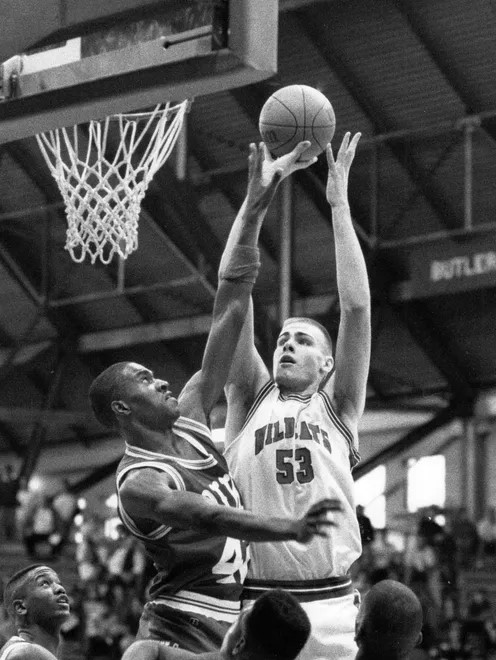
Indianapolis’ high school basketball legacy continues to grow. The IHSAA tournament moved to in 1975 and drew a then-record 17,490 fans to the title game. Broad Ripple won the 1980 crown, Cathedral reached the Final Four in 1982, and Eric Montross led Lawrence North to the 1989 championship. In 1990, 41,096 fans crowded the for the state finals, setting a national high school record. Southport reached the semifinals in 1990, while Brebeuf (1991) and Ben Davis (1993) also made Final Four appearances in the Dome, finishing as runners-up.
The story of Indianapolis girl’s high school basketball has become increasingly significant over the past two decades. For 76 years after the modest beginnings at Shortridge, progress in women’s athletics was slow and sporadic. Manual fielded intramural teams in 1899 and an interscholastic squad in 1902. Tech and the Deaf School soon followed and by the 1920s Acton, Ben Davis, Broad Ripple, Castleton, Lawrence, New Augusta, Southport, and Valley Mills mounted spirited contests.
Games were contested according to “girls’ rules,” with guards remaining at the defensive end of the court, forwards at the offensive end, and the center covering the entire floor. Uniforms, often made by the players themselves, consisted of long bloomers, blouses, scarves, and over-the-knee stockings. Girls’ games frequently served as curtain raisers to boys’ contests.
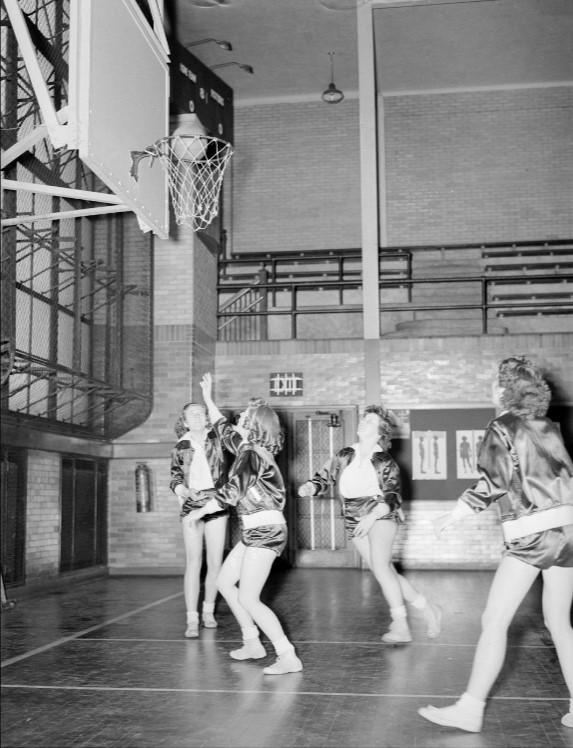
Whether due to financial constraints brought on by the or to the persistent notion that basketball was too strenuous and unladylike, girls’ interscholastic basketball in Indiana disappeared during the 1930s. Scattered intramural squads persevered, and an occasional interscholastic game was contested, but a sanctioned IHSAA girls’ tournament was not held until 1976.
Hinkle Fieldhouse hosted the 7,362 fans who witnessed Warsaw capture that historic championship. Arsenal Tech advanced to the inaugural Final Four and North Central (1979), Brebeuf (1982), (1983), Warren Central (1984), and Ben Davis (1992) reprised the feat. Southport won the 1980 State Championship behind Mental Attitude Award winner Amy Metheny and Brebeuf followed Parade magazine All-America Vicky Hall to the title in 1988. Washington’s Cheryl Cook was Miss Basketball in 1981, before winning All-America honors at the University of Southern California.
The IHSAA Girls’ Basketball Tournament moved to Market Square Arena in 1980. By 1989, 16,662 spectators were on hand for the championship tilt. With recent commitments to gender equity in interscholastic sports, the future appears bright for the growth of Indianapolis girl’s high school basketball.
A codicil is necessary. Only two (IPS) have ever made the girls’ Final Four, and after sending 16 teams to the championship round during the tournament’s first 58 years, only one IPS boys’ team has reached the Final Four in the past 24 years. While competition from pro sports, videos, drugs, and other diversions has negatively impacted many Indiana schools, some IPS games are contested before but a smattering of fans. Whether due to declining budgets, decaying facilities, or social factors like urban violence, IPS basketball has been overshadowed by suburban and private ventures.
Although interest in high school basketball has remained generally strong, the college game followed a more tortured path. Butler University was invited to the National Invitational Tournament (NIT) in 1958 and 1959, but the program fell into prolonged decline during the 1960s. As collegiate athletic budgets expanded exponentially, Butler attempted to maintain a major profile based on 1950s finances. By 1986, one season after a return to the NIT, a 9-19 Bulldog team drew only 2,406 fans per game to a dilapidated Hinkle Fieldhouse.

The university redressed the situation in 1989 with a $1.5-million renovation of the fieldhouse. Also, new head coach and former Butler captain, Barry Collier, received a 100 percent increase in the basketball budget. Recovery was rapid and dramatic. A 1978 charter member of the Midwest Collegiate Conference (MCC), Butler went from league doormat to contender. A 1991 NIT appearance was followed by a 21-10 record and the school’s first back-to-back, postseason invitations in 33 years.
The women’s program at Butler was founded in 1975. An NCAA Division I charter member of the MCC, the Women Bulldogs qualified for their first-ever postseason appearance in 1992-1993, posting a 23 -8 record and finishing sixth in the women’s NIT.
Butler’s historic rival, the University of Indianapolis (Indiana Central College), fielded its first men’s basketball team in 1913 and began an intercollegiate schedule in 1922. The NCAA Division II Greyhounds enjoyed their greatest success from 1947 to 1977 under Hall of Fame coach . In only its 15th year of existence, the U of I women’s team hosted and qualified for the 1993 NCAA Division II National Tournament first round. Both programs compete in the Great Lakes Valley Conference.
The men’s and women’s squads at joined NCAA Division II in 1993. Both teams were founded on the new urban campus during the early 1970s and enjoyed some success as independent members of the National Association of Intercollegiate Athletics (NAIA). The men won the NAIA District 21 Championship in 1985 and advanced to the National Final 16 in 1990. The Women Metros won District 21 titles in 1987 and 1990 and reached the NAIA Final Four in 1991.
began admitting men in 1954 and formed the school’s first male basketball team the same year. The women’s team, which had competed intercollegiately as the Maids since 1949, joined the men in becoming Knights. Marian is a member of the NAIA and competes in the Mid-Central Conference.
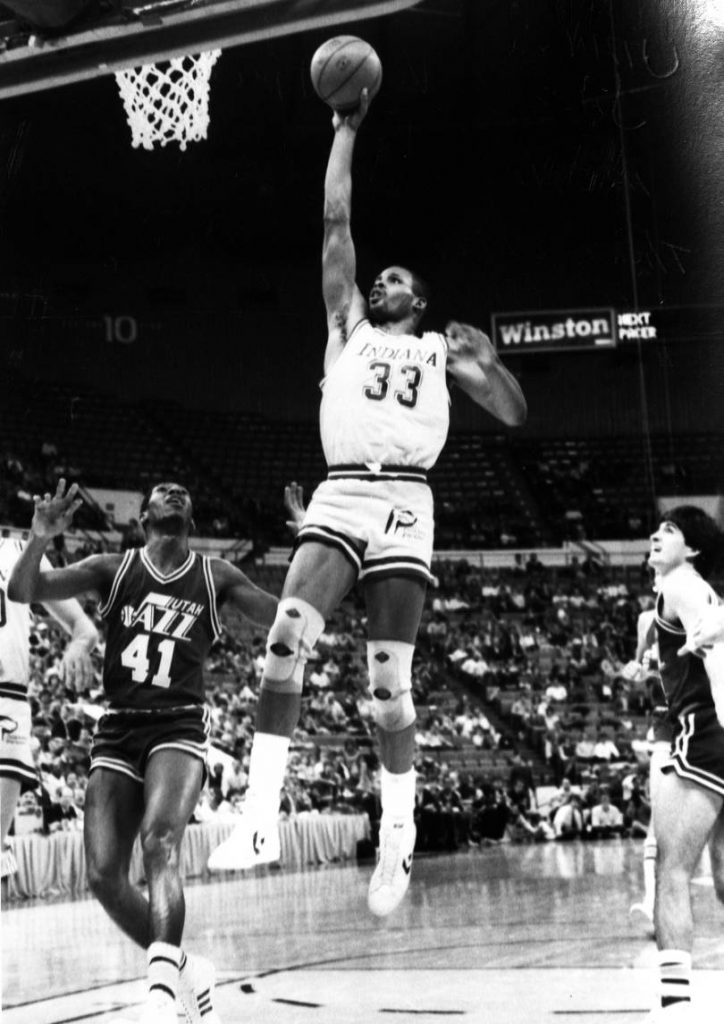
Professional basketball returned to Indianapolis in 1967 with the founding of the American Basketball Association (ABA). During the league’s nine seasons, the Indiana Pacers were a showcase franchise. The club won three league titles, produced three Most Valuable Players, hosted two All-Star Games, and annually led the league in attendance. When the chronically unstable ABA collapsed in 1976 the National Basketball Association (NBA) admitted the Pacers to membership. Concessions extracted by the established league and mismanagement, however, nearly destroyed the franchise. The club has habitually finished near the bottom of the league in wins and attendance. Locally owned since 1983, the club has stabilized somewhat in recent years. The team has reached the NBA playoffs four successive seasons, and though still low by league standards, the Pacers drew a franchise record 12,949 fans per game in 1992-1993.
Indianapolis’ place in basketball history is illustrated by recent example. In addition to setting the national high school attendance record, the 67,596 fans at the Hoosier Dome for the 1984 Olympic Team exhibition set the world record for the largest crowd to attend an indoor basketball game. An NBA single-game record of 43,146 witnessed the 35th All-Star game at the Dome in 1985, and in 1990 the three-session NCAA Division I men’s basketball first and second rounds drew 117,199 fans.
*Note: This entry is from the original print edition of the Encyclopedia of Indianapolis (1994). We are currently seeking an individual with knowledge of this topic to update this entry.
FURTHER READING
- Hoose, Phillip M., and Bobby Plump. Hoosiers, Third Edition: The Fabulous Basketball Life of Indiana. 3rd ed. Indiana University Press, 2016. https://search.worldcat.org/en/title/930683029.
CITE THIS ENTRY
APA:
Ogden, R. D. (1994). Basketball. Encyclopedia of Indianapolis. Retrieved Jan 5, 2026, from https://indyencyclopedia.org/basketball/.
MLA:
Ogden, R. Dale. “Basketball.” Encyclopedia of Indianapolis, 1994, https://indyencyclopedia.org/basketball/. Accessed 5 Jan 2026.
Chicago:
Ogden, R. Dale. “Basketball.” Encyclopedia of Indianapolis, 1994. Accessed Jan 5, 2026. https://indyencyclopedia.org/basketball/.

Help improve this entry
Contribute information, offer corrections, suggest images.
You can also recommend new entries related to this topic.
